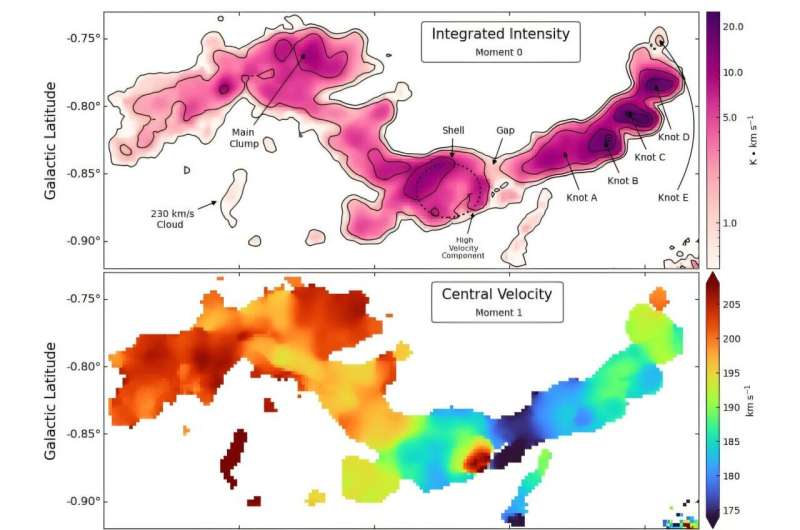
March 24, 2025 by Tomasz Nowakowski , Phys.org
Collected at: https://phys.org/news/2025-03-astronomers-giant-molecular-cloud-milky.html
Using the Green Bank Telescope (GBT), astronomers have detected a new giant molecular cloud in the Milky Way galaxy. The newfound cloud has a size of nearly 200 light years and its mass is estimated to be some 160,000 solar masses. The finding was reported in a paper published March 18 on the arXiv preprint server.
Molecular clouds are huge complexes of interstellar gas and dust left over from the formation of galaxies, composed mostly of molecular hydrogen. Molecular clouds with masses greater than 100,000 solar masses are called giant molecular clouds (GMCs). In general, GMCs are 15–600 light years in diameter and are the coldest and densest parts of the interstellar medium.
GMCs are gas reservoirs where most star formation takes place. Therefore, studying their lifecycle and characteristics is crucial to advancing our knowledge about the formation and evolution of galaxies.
Now, a team of astronomers led by Natalie O. Butterfield of the National Radio Astronomy Observatory (NRAO) reports the detection of a new GMC, which received designation M4.7-0.8. The cloud was identified at the midpoint of a dust lane of the Milky Way’s bar—at a distance of about 23,000 light years. The dust lanes of the Galactic bar are essential in transporting material from the disk toward the Milky Way’s center, where it forms dense, ring-like structures that become sites of intense star formation.
“We report the detection of a previously unknown giant molecular cloud located at the midpoint of the near-side Galactic bar dust lanes (M4.7-0.8). In this publication we present 25 GHz radio observations of dense gas that is associated with material accreting into the Galactic center,” the researchers wrote in the paper.
According to the study, M4.7-0.8 has a length of roughly 195 light years in Galactic longitude and a vertical extent of about 65 light years in Galactic latitude. The mass of the cloud was calculated to be 160,000 solar masses, and its cold dust temperature was estimated to be at a level of 20 K.
Based on the observations, the astronomers distinguished two main features of M4.7-0.8, which they dubbed the “Nexus” and “Filament.” Nexus coincides with the brightest carbon monoxide (CO) emission and appears correlated with the nexus of the dust continuum and CO emission. When it comes to the Filament, it is a narrow dust continuum feature that appears to be an extension of the Nexus and showcases a filamentary morphology.
Moreover, the study also identified two sites of possible star formation in M4.7-0.8—Knot B and Knot E. The researchers noted that Knot E, which is dense and displays a cometary-like structure, may be a possible free-floating evaporating gas globule, but it needs to be further investigated.
The observations also found that M4.7-0.8 also harbors what appears to be a shell-like structure. This structure appears to contain a brighter rim in the ammonia emission, with a cavity towards its center.
More information: Natalie Butterfield et al, Discovery of a Giant Molecular Cloud at the Midpoint of the Galactic Bar Dust Lanes: M4.7-0.8, arXiv (2025). DOI: 10.48550/arxiv.2503.14174
Journal information: arXiv

Leave a Reply